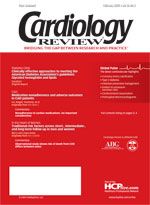Publication
Article
Cardiology Review® Online
Reducing inflammatory biomarkers: What does it mean?
Author(s):
The principal finding of this study is that among patients with type II diabetes and mixed dyslipidemia, treatment with simvastatin, fenofibrate, or their combination was associated with reductions in inflammatory biomarkers high-sensitivity C-reactive protein (hsCRP) and lipoprotein-associated phospholipase A2 (Lp-PLA2).
The principal finding of this study is that among patients with type II diabetes and mixed dyslipidemia, treatment with simvastatin, fenofibrate, or their combination was associated with reductions in inflammatory biomarkers high-sensitivity C-reactive protein (hsCRP) and lipoprotein-associated phospholipase A2 (Lp-PLA2). The treatment effect was most pronounced among patients with increased baseline levels of both biomarkers.
Several findings in this study merit comment. First, the median levels of hsCRP (2.11mg/L) are lower than levels typically reported for diabetic populations (>3 to 4 mg/L)1 and are consistent with American Heart Association/Centers for Disease Control and Prevention (AHA/CDC) criterion of “average” risk.2 Whether this is due to difference in degree of glycemic control or insulin resistance (correlates of inflammation) is not apparent from this study.
Second, the justification for the cut-off value for hsCRP (2.0mg/L) is not stated—it is lower than the observed median value of 2.11mg/L and much lower than the AHA/ CDC cut-off of >3 mg/L for “high” risk.2 This can potentially have a material impact on the results.
Third, the exact mechanism(s) for the biomarker-lowering effect of statins or fibrates is not clear. Proposed mechanisms include lipid-independent pathways including an anti-inflammatory effect,3 and direct (via transcription factors)4 or indirect (via upregulation of nitric oxide)5 inhibition of hepatic CRP synthesis by statins. The lack of correlation between hsCRP and lipid variables and lack of dose-response for biomarker-lowering effect compared to lipid-lowering effect in this study suggests that lipid-independent mechanisms might be primarily involved. Although Lp-PLA2-lowering effect of statin was significantly related to low-density lipoprotein reduction, the later accounted for only 12% (R2, R = 0.35) of the variability in response, suggesting other mechanisms might be operative. Whether or not the biomarker-lowering effect of statins (or fibrates) reflects their anti-inflammatory effect should ideally require a parallel reduction on more proximal inflammatory biomarkers such as interleukin-6, interleukin-1β‚ or tumor necrosis factor-α for conclusive evidence. However, this has not been demonstrated consistently.3 Thus, the prospect that some of the benefits conferred by statins (or fibrates) may accrue independently of their effects on lipid profiles remains intellectually intriguing and warrants further scrutiny.
Finally, the clinical utility of hsCRP and Lp-PLA2 in aiding cardiovascular risk stratification or in titrating the intensity of lipid-modifying therapy is undetermined. The AHA/CDC clinical guidelines currently recommend measurement of hsCRP to complement cardiovascular risk stratification in only healthy population with “moderate” cardiovascular risk (10% to 20% in 10 years; class IIa, level of evidence B).2 Recent evidence from the Strong Heart Study in American Indians, in which hsCRP was not associated with cardiovascular disease risk in diabetic individuals, suggests that the predictive ability of hsCRP may not be uniform across subgroups, particularly in high-risk individuals such as those with diabetes (considered a coronary heart disease risk equivalent).1 Despite the growing number of epidemiologic studies assessing Lp-PLA2 in primary or secondary prevention populations, its role in routine clinical practice has not been fully established and is not currently recommended.2 Key additional issues yet to be resolved include whether hsCRP and Lp-PLA2 can be used as a therapeutic goal or as empirical markers associated with reduction of cardiovascular disease risk in diabetics. The answers will have to await the results of the upcoming ACCORD trial that will have potential important considerations for implementing the clinical use of hsCRP and Lp-PLA2.






